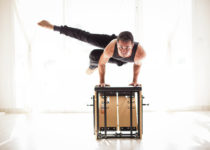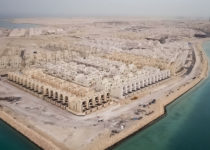A third day of panel sessions, interactive workshops, and artistic performances has come to an end at CultureSummit Abu Dhabi 2019. Organised by Department of Culture and Tourism – Abu Dhabi (DCT Abu Dhabi), the event is taking place through 11 April at Manarat Al Saadiyat in Abu Dhabi.
Over five days, CultureSummit Abu Dhabi 2019 is presenting a dynamic series of panel discussions and interactive workshops under the topics of art, media, heritage, museums, and technology, as well as cultural performances and networking events. This edition’s theme of ‘Cultural Responsibility & New Technology’ addresses questions of how cultural agents can be more engaged in addressing global challenges, and how creativity and technology may be harnessed for positive change.
Day Three kicked off with What are the new frontiers?, a session moderated by John Prideaux, US Editor at The Economist, exploring how innovation and new ways of thinking are opening up new horizons in the news and in cultural media. How are these transforming our interaction with, and interpretation of, the world around us?
•Amar Bakshi, Founder, Shared_Studios spoke about his ‘Portals’ project, which uses technology to connect strangers from diverse backgrounds. Shipping containers are set up in cities around the world, where people can come to take part in a live video conference with a person from another country, and a completely different background. In facilitating conversation, the project aims to forge connections between diverse groups, and teach us to embrace difference. It utilises technology to unite rather than separate us, which is often the case. He observed that technological institutions address us as individual consumers, rather than being a true community resource, and integrating tech into our lives this way has consequences.
•Maher Chmaytelli, Head of the Middle East and North Africa Breaking News Desk, Reuters spoke about the revolution in war reporting due to the developments in satellite imagery. Image resolution has become so good that journalists have full access to a place, which is most of what they need to get the story. Also the rise of social media and blogging has changed the business hugely – each person can be a news reporter, even in the smallest, most remote village. Residents can be live tweeting from war zones, even during a media blackout when no reporters have access.
•Ricardo Karam, Talk Show Host and Founder of TAKREEM Foundation revealed that he has had difficulty dealing with such rapid technological changes in the last decade. In today’s news cycle, the focus is on images and sensational or fake news, not the human element. He spoke to the need for role models and inspirational figures, particularly in the region. So with his journalism, he has decided to focus on human nature, searching for remarkable people to profile around the world. But even this has proven controversial; the region is in such turmoil that there is no neutral subject.
What constitutes public art? explored the notion of this art form, with moderator Tim Marlow, Artistic Director of the Royal Academy of Arts, asking: Is public art a category in its own right? Does working in the public domain shift the responsibility of artists? Do public monuments still have meaning in the 21st century, and should commissioners look very carefully at permanence versus temporariness?
•Artist Wael Shawky explained how his work investigates and focuses on societies in transition and the dream of development. Much of his work is not public art in the sense that we normally think of, but more public performances, such as a film he made of him walking through a grocery store, reciting a passage from the Quran. He stated that he believes artists do have a certain responsibility in their public art, and it should certainly never veer into propaganda.
•Architect Farshid Moussavi OBE observed how art and architecture have grown more distinct from each other today, whereas before, architecture was considered an art form. Public art is sometimes now seen as a way to fix ‘bad’ architecture. She posited that collaboration is key; architects are great collaborators and cooperation and exchange with artists can yield fantastic results; however, when public art is forced onto developments, it is often not successful. She also noted that architects never escape the public arena; it is always a dimension of their work.
•Artist Oliver Beer talked about his art practice, which oscillates between monumental and intimate, often focusing on sound. He captures the sound and frequencies of objects, with one piece forming an ‘orchestra’. In his largest public art piece, he microphoned the riverbed of the Seine. He noted that private work might be private for a while, but if it survives long enough, it eventually becomes public. Art that is socially engaged is eroding the ability for public audiences to be indifferent.
•Artist Michael Craig-Martin said that when crafting public art, making in relation to place is crucial, as are considerations of audience and scale. He explained the three different public reactions to public art: indifference, alienation, and engagement. With audience considerations being so important, sometimes the restraints placed on public art can make the creative process more interesting. He believes that with public art, permanent monuments are outdated; rather, temporary works make more sense in our time. He noted the difficulty of creating something that will have public resonance over a long period of time; things move on, tastes change, buildings get torn down.
In recent years, a number of technological developments have revolutionised the heritage field, in particular in the documentation, study and public presentation of cultural properties and artefacts. How can new technologies support heritage in emergencies?, moderated by Oliver van Damme, Programme Specialist for Planning and Coordination at UNOSAT, explored the potential of these new developments in relation to the specific needs associated with the protection of cultural heritage in the context of crisis situations.
•Yves Ubelmann, President of ICONEM talked about ICONEM’s work in developing new tools to document at-risk sites and monuments in 3D. Formed as a reaction against the systematic disappearance of heritage, it has worked on projects in 30 countries around the world. Archaeologists can use these digital copies to understand the site from afar, forming a bridge between the scientific community and communities at war. He also realized that these images can be used for public exhibition, allowing people to ‘visit’ inaccessible sites. He noted that sometimes, documenting can raise awareness of and even save sites from destruction.
•Dr. Emma Cunliffe, Research Associate, Cultural Property Protection and Peace, Newcastle University, noted the usefulness of satellite imagery in her work, as it makes information available about areas that are simply not safe to go to. This imagery enables rapid assessments to be made, gives a sense of the scale of damage and the resources needed, and raises public awareness. Especially helpful is the transferable nature of this technology; she and her colleagues have been able to train professionals in various countries, so they can develop and take ownership of the technology and use it to create a national heritage inventory.
•Kristin Parker, Cultural Heritage Consultant spoke about her work with refugees, noting that “cultural heritage acts as a wayfinding sign, reorienting people after disaster”. She believes that archivists need to be proactive in preserving the historical record right now. People have always used whatever technology is available to them to preserve their lives and memories. She has found that for displaced people today, smartphones have huge importance; not only are they tools of communication and navigation, but they are repositories, holding images and memories that are sometimes the only ones they have left.
•Martin Roeske, Senior Manager Public Policy and Government Relations, Google relayed the work Google Arts and Culture initiative has been doing, with an aim to make art available to anyone from anywhere for free. They saw a gap in the telling of the stories behind artworks and artefacts. For those who cannot visit sites and institutions, technology can enable an immersive experience from afar. Google has used Super HD cameras to capture paintings and 3D objects, and utilised the Streetview technology to capture archaeological sites; now they are experimenting with Augmented Reality. Their technology has been useful in light of emergencies as well; Google captured the collection of the National Museum in Brazil before the fire, as well as much of the Mosul Museum.
The final panel of the day was How are the new publics shaping our new museums? Across the world, new museums focusing on contemporary art are opening at an unprecedented rate. Moderated by Richard Armstrong, Director, Solomon R. Guggenheim Museum and Foundation, this session sought to identify the forces shaping this museum boom, and examine how the emerging local, global, young and digitally-native public is impacting museum culture today.
•Kulapat Yantrasast, Architect, wHY spoke to the essential role architecture plays part in the conception of a new museum, as these institutions have evolved from “temples of culture” to more of a platform. They are not just physical buildings but an experience, and the architecture is part of the museum brand. In redefining their content, museums must look at who their audiences are and consider their expectations. He noted that today, museums are competing to be relevant with all the other noise of modern life, and asked: why compete and not join? In his opinion, the important questions are how architecture can help people’s lives flourish, and how to use the power of architecture to create sense of community.
•Suhanya Raffel, Director, M+, Hong Kong introduced the concept behind the “more than a museum” institution, M+, still being created in Hong Kong’s West Kowloon district. In creating a new museum of visual culture, she and her team have had to think deeply about how museums provide historical, aesthetic and social value. She noted that they are working to ensure their expertise and knowledge is valued and applied in a conventional museum sense; however, the way they engage with audiences is unconventional. She believes that when working with youth communities and audience building, integrity is an essential part of delivery.
•Madeleine Grynsztejn, Director, MCA Chicago provided the background of her institution, noting that it was founded as a space for contemporary and experimental art, as well as a commissioning body. Of the museum’s ethos, its motto “artist activated, audience engaged” guides everything they do. She believes that expertise is not the same as elitism; to reinforce this, the way the museum communicates expertise is more informal and accessible, as much about process as content. MCA Chicago makes a concentrated effort to ensure that their increasingly diverse audiences are reflected in the makeup of their staff and their Board. Forging common social bonds is a mandate in today’s troubled times, and she considers “dialogue as the conduit to community”.
•Aaron Seeto, Director, MACAN, Jakarta spoke about his young institution, the first contemporary art museum in Indonesia. He noted that although they are a private museum, they very much understand that they operate in the public sphere. Their main driver is education, and many of their internal conversations have revolved around process: how to communicate, how to educate. As for audiences, he posits that people need to feel like they are reflected in the programming, so while experimentation is necessary, institutions must also not be afraid of doing things that are popular.
The Day Three artistic performances were a slam-poetry delivery by Saul Williams, the American rapper, singer-songwriter, musician, slam poet, writer, and actor; a commentary on the exploitative labour practices in her home country of Thailand by performance artist Kawita Vatanajyankur; and a dance piece by Dickson Mbi and Maya Jilan Dong.
The afternoon sessions were workshops based on brainstorming key issues, through a cross-sectorial thinking process brought forward by the participants of the Summit. With Day One’s workshops formulating key questions and Day Two’s seeking answers, today’s workshops began to develop concrete and impactful actions for cultural leaders, artists, institutions and governments to act upon.
Day Three’s activities were capped by a special tour of Louvre Abu Dhabi for delegates of CultureSummit.
*
CultureSummit Abu Dhabi is a unique global platform that brings together leaders in arts, heritage, media, museums, and technology to identify ways in which culture can play a pivotal role in raising awareness of global issues, building cultural bridges and promoting positive change. The event aims to determine an annual cultural agenda that will address the world’s pressing challenges and provide practical solutions.
Under the theme ‘Cultural Responsibility & New Technology’, this year’s programme features panel discussions, performances and interactive workshops crafted in collaboration with five cultural partners representing influential sectors in the fields of media, heritage, arts, museums and technology.
CultureSummit 2019’s five partners are The Economist Events, providing expertise in discussing issues related to media, information and its policies; UNESCO, addressing the tangible and intangible role of heritage in societal change; the Royal Academy of Arts, confronting pressing issues from the international art world; the Solomon R. Guggenheim Museum and Foundation, exploring how museums can shape the future of culture; and Google, heading the technology stream to craft discussions related to technology’s impact on arts, culture and media.
Etihad Airways is the Official Airline Partner of CultureSummit Abu Dhabi 2019.
While CultureSummit Abu Dhabi is an invitation-only event, the public is invited to watch the livestreaming of the daytime performances and panel discussions via the website at www.culturesummitabudhabi.com.







